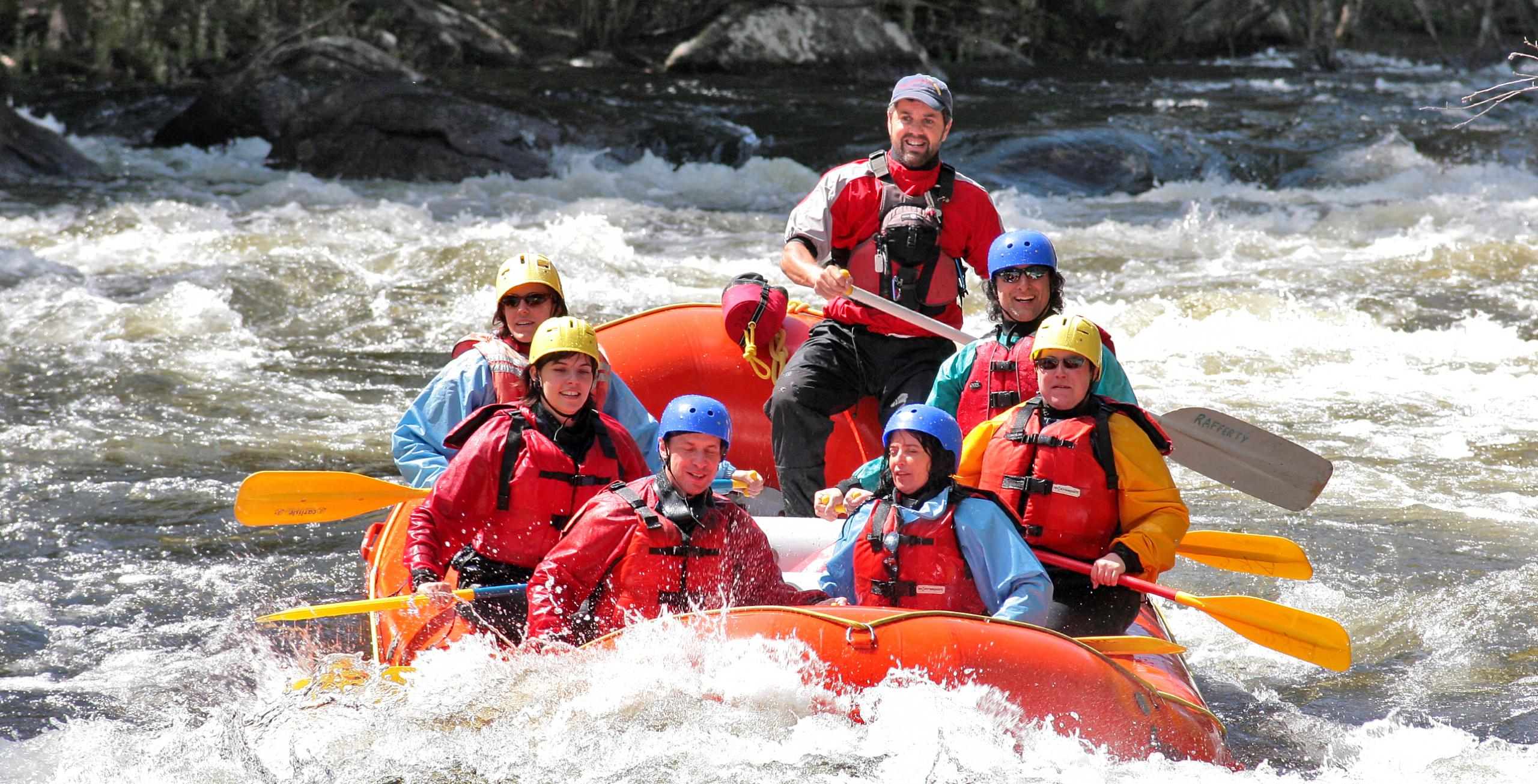
Running The Rapids
A whitewater raft lightly bounces over riffles in a river. Six passengers sit on the sides of the raft. Each person holds a paddle. At the back is the guide. He is an experienced rafter and knows how to steer the boat safely. As the raft drifts, the passengers marvel at the stunning canyon walls that rise around them.
The riffles get stronger and the current begins to move swiftly. Ahead, the passengers see rapids. The water flows so quickly that it looks white. The raft enters the rapids, and waves splash onto the passengers. Their hearts race. “Forward!” shouts the guide. The passengers dig their paddles into the water and pull hard. The guide steers the raft around rocks. He directs it through a safe passage. Soon, the raft enters calm water again. The passengers can hardly wait to see what is around the next bend. They are excited to run more rapids!
Whitewater is a powerful, turbulent flow of water. It is found in rapids, waterfalls, and other fast-moving parts of rivers. In whitewater rafting, people paddle through flowing water in blow up, inflatable boats called rafts. They use paddles and oars to steer the rafts down the river and through rapids.
Thousands of people go whitewater rafting each year. Many enjoy the thrill of running the rapids. Others prefer a calm ride down a lazy river. They watch the scenery and look for wildlife. People of all ages can go whitewater rafting. Many enjoy spending the day or just a few hours on a river. Others choose multi-day trips. These rafters paddle during the day and camp along the river at night. Many hike and explore the area when they are not on the water.
Whitewater Rafts
Whitewater rafts come in different shapes and sizes. A typical raft has room for four to ten rafters and an experienced guide. The guide steers the raft and gives instructions. Rafts come with footholds and handholds to help people stay on board. Many rafters use dry bags to keep personal belongings from getting wet. These and other gear such as first aid kits, food, and drinking water are tied into the boat. That way, nothing will float away if the raft flips over.
Most rafts are self-bailing. This gives the raft that ability to remove water that gets into it. The floor of the raft is raised above the surface of the water. Water that splashes into the raft flows out through laces that are lower than the floor. This prevents the raft from filling up with water and sinking.
Whitewater rafters usually ride in either paddle rafts or oar rafts. Everyone is part of the crew on a paddle raft. Rafters sit on the outside edges of the raft with their feet flat on the floor. Everyone has a paddle. A captain or guide sits at the back and calls out the strokes. These include “forward” and “back.” The rafters follow the guide’s orders. When the guide calls “drift” or “stop,” rafters pull their paddles out of the water to let the raft float.
Other rafts are steered with long paddles called oars. In these oar rafts, the guide sits in the center of the boat. He or she steers and paddles the boat with the oars. Other rafters do not have to do any work. They just hold on and enjoy the ride! On some oar rafts, people have the option to paddle. However, the guide is still responsible for steering.
River Obstacles
Rafters use a scale to help them choose the best river for them. People looking for a low-key float choose Class I or II rivers. These slow-moving rivers have small waves and few obstacles. Class III rivers have more obstacles and waves up to 3 feet (0.9 meters) high. Rafters on these rivers should have some whitewater experience. Expert rafters choose Class IV and Class V rivers. They have challenging obstacles, strong waves, and big drops. Class VI rivers are extremely dangerous. Even experts are warned to avoid them.
Sometimes sections of the same river are different classes. This depends on the type of obstacles that are part of rapids. A hole is an obstacle where water flows down over a rock and creates a hole in the bottom of the river. Water from downstream rushes back up to fill the hole. This creates a swirl of whitewater that can trap rafts or people underwater. A narrow, empty space between rocks is called a sieve. Water can flow through a sieve but rafts cannot. This water is powerful and can overturn rafts.
Strainers are usually large tree branches or bushes that have fallen in the river. These obstacles allow water to flow through them, but they prevent the passage of rafts. A poorly steered raft can become pinned against a strainer. If this happens, the current can force the raft under the water. Trees rooted to land that have branches hanging over the river are sweepers. They can sweep people off the raft and into the river.
Often, a bend in the river prevents rafters from seeing obstacles ahead. They may need to go ashore to scout the river. This allows them to plan a safe route. If the rapids are too dangerous, rafters may decide to walk around them and put in down river.
Staying Safe in the Rapids
Before a trip, guides teach rafters basic paddling strokes and cover safety rules. All rafters must watch for obstacles and alert the guide to any dangers. Sometimes rafts flip over or people fall in the water. Guides refer to people out of the raft as swimmers. Anyone can become a swimmer. This is why rafters must always wear a life jacket. It keeps a swimmer’s head above water. Other rafters can grab the life jacket’s shoulder straps to pull a swimmer back into the raft.
Guides train rafters on what to do in case they take an unexpected swim. Swimmers should lie on their backs with their feet in front of them. This is called defensive swimming. It helps swimmers avoid getting their feet caught and softens shocks from bumping into rocks. Then swimmers should wait for a guide to navigate a raft close to them. Other rafters get ready to pull them into the boat. Sometimes, people must swim to shore. For this reason, all rafters should be able to swim.
People should only go rafting in groups of two or more. This way, someone can go for help in case of an accident or injury. Paddles are the most common cause of whitewater rafting injuries. Rafters should keep their paddles down and outside the boat. However, rafters may accidentally swing their paddles during an exciting run. For this reason, rafters should always wear helmets. If a rafter goes overboard, a helmet will also protect against rocks in the water.
Rafters enjoy the experience even more when they are in good physical shape. Paddling through fast-moving water requires strength and endurance. To stay comfortable, rafters should dress for the water temperature. Those rafting in cold water dress in layers. They often wear paddling jackets or wet suits. When water temperatures are warm, rafters wear quick drying fabrics. All rafters should wear shoes that can get wet.
Whitewater Fun on the Colorado River
The Colorado River has some of the most thrilling whitewater rafting in the United States. The river begins in the Rocky Mountain wilderness of Colorado. It winds through Utah and down the western edge of Arizona into Mexico. Depending on where they put in, rafters can float by towering red rocks, mountains, or waterfalls. They may glimpse ancient ruins and wildlife along the shore.
The Colorado River offers rafters of all ages and abilities a fun-filled adventure. The most advanced rafters can face Class V rapids in Colorado’s Gore Canyon. Here, the river flows furiously down a small waterfall. Rafters must use all of their wits to find safe passage through these roaring waters. For many rafters, paddling Gore Canyon is the ride of a lifetime!



 About BeeLine
About BeeLine